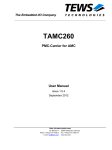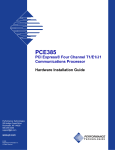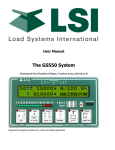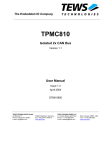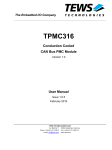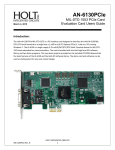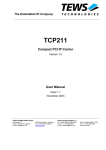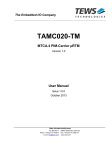Download TAMC100 - powerbridge.de
Transcript
The Embedded I/O Company TAMC100 Carrier for 1 Industry Pack® User Manual Issue 1.0 July 2008 TEWS TECHNOLOGIES GmbH Am Bahnhof 7 Phone: +49-(0)4101-4058-0 25469 Halstenbek, Germany Fax: +49-(0)4101-4058-19 www.tews.com e-mail: [email protected] TEWS TECHNOLOGIES LLC 9190 Double Diamond Parkway, Suite 127, Reno, NV 89521, USA www.tews.com Phone: +1 (775) 850 5830 Fax: +1 (775) 201 0347 e-mail: [email protected] TAMC100-10 AMC Carrier for 1 IndustryPack, Mid-size, HD50 SCSI-2 front I/O connector TAMC100-10R RoHS compliant version of TAMC100-10 TAMC100-11 AMC Carrier for 1 IndustryPack, Full-size, HD50 SCSI-2 front I/O connector TAMC100-11R This document contains information, which is proprietary to TEWS TECHNOLOGIES GmbH. Any reproduction without written permission is forbidden. TEWS TECHNOLOGIES GmbH has made any effort to ensure that this manual is accurate and complete. However TEWS TECHNOLOGIES GmbH reserves the right to change the product described in this document at any time without notice. TEWS TECHNOLOGIES GmbH is not liable for any damage arising out of the application or use of the device described herein. RoHS compliant version of TAMC100-11 Style Conventions Hexadecimal characters are specified with prefix 0x, i.e. 0x029E (that means hexadecimal value 029E). For signals on hardware products, an ‚Active Low’ is represented by the signal name with # following, i.e. IP_RESET#. Access terms are described as: W Write Only R Read Only R/W Read/Write R/C Read/Clear R/S Read/Set ©2008 by TEWS TECHNOLOGIES GmbH TAMC100 User Manual Issue 1.0 Page 2 of 26 Issue Description Date 0.2 Preliminary Issue February 2008 1.0 Initial Issue July 2008 TAMC100 User Manual Issue 1.0 Page 3 of 26 Table of Contents 1 2 3 PRODUCT DESCRIPTION ......................................................................................... 6 TECHNICAL SPECIFICATION................................................................................... 7 PEX8311 TARGET CHIP............................................................................................ 8 3.1 PEX8111 ...........................................................................................................................................8 3.1.1 PCI Express Configuration Space Register Mapping ..........................................................8 3.2 PCI9056 ..........................................................................................................................................10 3.2.1 PCI Configuration Registers (PCR) ...................................................................................10 4 REGISTER ADDRESSING ....................................................................................... 11 4.1 PCI9056 PCI Base Address Configuration .................................................................................11 4.2 IP I/O, ID, INT Space and Interface Registers.............................................................................11 4.2.1 Revision ID Register (0x400) .............................................................................................12 4.2.2 IP Control Register (0x402) ...............................................................................................13 4.2.3 IP Reset Register (0x40A) .................................................................................................14 4.2.4 IP Status Register (0x40C) ................................................................................................15 4.3 IP Interrupts ...................................................................................................................................16 4.4 IP Memory Space ..........................................................................................................................16 5 CONFIGURATION HINTS ........................................................................................ 17 5.1 Big / Little Endian..........................................................................................................................17 5.2 Configuration EEPROM ................................................................................................................18 5.2.1 PEX8111 EEPROM ...........................................................................................................18 5.2.2 PCI9056 EEPROM.............................................................................................................18 5.3 PCI9056 Interrupt enable..............................................................................................................19 6 MODULE MANAGEMENT ....................................................................................... 20 6.1 Indicators .......................................................................................................................................20 6.1.1 On Board Link-LED ............................................................................................................20 6.1.2 Front Panel LEDs...............................................................................................................20 6.2 Temperature and Voltage Sensors..............................................................................................20 6.3 Connectivity...................................................................................................................................21 7 INSTALLATION........................................................................................................ 22 7.1 AMC Module Insertion & Hot-Swap.............................................................................................22 7.1.1 Insertion .............................................................................................................................22 7.1.2 Extraction ...........................................................................................................................22 7.2 Installation of IndustryPacks .......................................................................................................22 7.3 Component Height Violation on TAMC100-x0 ...........................................................................23 7.4 Voltage Limits on IndustryPack Modules...................................................................................23 7.5 Fuses and Filters...........................................................................................................................23 8 PIN ASSIGNMENT ................................................................................................... 24 8.1 Overview ........................................................................................................................................24 8.2 IP Connector J1.............................................................................................................................24 8.3 I/O Connectors J2 and X1 ............................................................................................................25 8.3.1 Front Panel I/O Connector X1............................................................................................26 8.4 IP Strobe Signal J3........................................................................................................................26 TAMC100 User Manual Issue 1.0 Page 4 of 26 Table of Figures FIGURE 1-1: BLOCK DIAGRAM........................................................................................................................6 FIGURE 2-1: TECHNICAL SPECIFICATION.....................................................................................................7 FIGURE 3-1: PCI-COMPATIBLE CONFIGURATION REGISTERS (TYPE 1) ..................................................8 FIGURE 3-2: PCI-COMPATIBLE CAPABILITY REGISTERS ...........................................................................9 FIGURE 3-3: PCI CONFIGURATION REGISTERS (PCR) .............................................................................10 FIGURE 4-1: PCI BASE ADDRESS CONFIGURATION .................................................................................11 FIGURE 4-2: IP I/O, ID, INT SPACE AND INTERFACE REGISTER SPACE.................................................11 FIGURE 4-3: REVISION ID REGISTER ..........................................................................................................12 FIGURE 4-4: IP CONTROL REGISTER ..........................................................................................................13 FIGURE 4-5: IP RESET REGISTER................................................................................................................14 FIGURE 4-6: IP STATUS REGISTER..............................................................................................................15 FIGURE 4-7: IP MEMORY SPACE..................................................................................................................16 FIGURE 5-1: LOCAL BUS LITTLE/BIG ENDIAN.............................................................................................17 FIGURE 5-2: PCI9056 CONFIGURATION EEPROM DATA ...........................................................................19 FIGURE 6-1: ON BOARD LINK-LED ...............................................................................................................20 FIGURE 6-2: FRONT PANEL LEDS ................................................................................................................20 FIGURE 6-3: TEMPERATURE AND VOLTAGE SENSORS ...........................................................................20 FIGURE 7-1: AMC MODULE INSERTION.......................................................................................................22 FIGURE 7-2: AMC MODULE EXTRACTION ...................................................................................................22 FIGURE 7-3: COMPONENT HEIGHT VIOLATION .........................................................................................23 FIGURE 7-4: VOLTAGE LIMITS ......................................................................................................................23 FIGURE 7-5: FUSE CURRENTS .....................................................................................................................23 FIGURE 8-1: CONNECTOR OVERVIEW ........................................................................................................24 FIGURE 8-2: IP J1 LOGIC INTERFACE PIN ASSIGNMENT..........................................................................24 FIGURE 8-3: PIN ASSIGNMENT I/O CONNECTORS ....................................................................................25 FIGURE 8-4: FRONT PANEL I/O CONNECTOR NUMBERING .....................................................................26 TAMC100 User Manual Issue 1.0 Page 5 of 26 1 Product Description The TAMC100 is a standard single width / mid-size or full-size AMC.1 compliant carrier for one singlesize IndustryPack (IP) module used to build modular, flexible and cost effective I/O solutions for applications in process control, medical systems, telecommunication and traffic control. A HD50 SCSI2 type connector provides access to all IP I/O lines. The TAMC100 is a versatile solution to upgrade well known legacy I/O solutions to a high performance form factor. All IP interrupt request lines are mapped to PCIe INTA; alternatively Message Signaled Interrupts (MSI) can be used. For fast interrupt source detection the TAMC100 provides a special IP interrupt status register. The IP power lines are fuse protected by self healing fuses and RF filtered. The operating temperature range is -40°C to +85°C. According to AMC.0, the TAMC100 provides an IPMI compliant Module Management Controller (MMC) with temperature monitoring and hot-swap support. The TAMC100 is available as mid-size module or as full-size module. The mid-size option has restrictions to its usage because of a component height violation, but allows improving the density of a µTCA system. IP Bus IP I/O IP Slot IP Interface Local Bus PCI Express to Local Bridge PCI9056 PEX8111 IPMB PCIe(1x) AMC Edge Connector HD50 SCSI-2 Connector MMC Figure 1-1: Block Diagram TAMC100 User Manual Issue 1.0 Page 6 of 26 2 Technical Specification AMC Interface Mechanical Interface Advanced Mezzanine Card (AMC) Interface confirming to PICMG® AMC.0 R2.0 Mid / Full Size Electrical Interface PICMG® AMC.1 R1.0 PCIe single lane (x1) port (AMC.1 Type 1 compliant) IPMI IPMI Version 1.5 Front Panel LEDs Blue Hot-Swap LED Red Power Good LED (LED1) Green IP-Activity LED (LED 2) On Board Devices PCI Express Target Chip PEX8311 (PLX Technology) IP Interface IP Interface According to IndustryPack specification ANSI / VITA 4-1995 IP Slots One single-size IP IP Access 8 / 16 bit 8 / 32 MHz 8 Mbyte memory space Mapping of IP Interrupts Routing of all IP interrupts to PCIe INTA/MSI, local interrupt status register DMA Not supported 32-Bit Access Not supported Protection Self Healing fuses and RF-filtering on all IP power lines I/O Interface I/O Connector Front-I/O via HD50 SCSI-2 type connector Physical Data Power Requirements tbd. typical @ +12V DC (Payload Power) tbd. typical @ +3.3V DC (Management Power) Additional power is required by IP modules Temperature Range Operating Storage MTBF 633.000 h -40°C - +85°C -40°C - +85°C MTBF values shown are based on calculation according to MIL-HDBK-217F and MIL-HDBK-217F Notice 2; Environment: GB 20°C. The MTBF calculation is based on component FIT rates provided by the component suppliers. If FIT rates are not available, MIL-HDBK-217F and MIL-HDBK-217F Notice 2 formulas are used for FIT rate calculation. Humidity 5 – 95 % non-condensing Weight 100 g Figure 2-1: Technical Specification TAMC100 User Manual Issue 1.0 Page 7 of 26 3 PEX8311 Target Chip The PEX8311 internally consists of two devices, a PEX8111 (PCI Express to PCI bridge) and a PCI9056 (PCI to local bus bridge). These are visible as two separate devices with own headers on the PCI/PCIe bus. In the following chapters both the PEX8111 and the PCI9056 are described as independent devices. 3.1 PEX8111 3.1.1 PCI Express Configuration Space Register Mapping 3.1.1.1 PCI CFG Register Address PCI-Compatible Configuration Registers (Type 1) 31 24 23 16 15 8 7 0 Read after initialization write access 0x00 PCI Device ID PCI Vendor ID 10B5 8111 0x04 PCI Status PCI Command 0010 0000 0x08 0x0C PCI Class Code PCI Built-In SelfTest (Not Supported) PCI Header Type Internal PCI Bus Latency Timer PCI Device Revision ID 060400 21 PCI Cache Line Size 00 01 00 00 0x10 PCI Base Address 0 0000000C 0x14 PCI Base Address 1 00000000 0x18 0x1C Secondary Latency Timer Subordinate Bus Number Secondary Status Secondary Bus Number Primary Bus Number 00 00 00 00 I/O Limit I/O Base 0200 00 00 0x20 Memory Limit Memory Base 0000 0000 0x24 Prefetchable Memory Limit Prefetchable Memory Base 0000 0000 0x28 Prefetchable Memory Base Upper 32 Bits 0x2C Prefetchable Memory Limit Upper 32 Bits 0x30 I/O Limit Upper 16 Bits 0x34 0x38 0x3C 00000000 00000000 I/O Base Upper 16 Bits Reserved 0000 0000 PCI Capabilities Pointer 000000 40 Internal PCI Interrupt Line 0000 01 00 PCI Base Address for Expansion ROM (Not Supported) Bridge Control Internal PCI Interrupt Wire Figure 3-1: PCI-Compatible Configuration Registers (Type 1) TAMC100 User Manual Issue 1.0 Page 8 of 26 3.1.1.2 PCI CFG Register Address 0x40 0x44 PCI-Compatible Capability Registers 31 24 23 16 Power Management Capabilities Power Management Data 0 Power Management Capability ID Power Management Control/Status 0x58 Read after initialization write access CA02 5001 00 00 0000 0000 0000 Reserved Message Singled Interrupts Control 0x54 0000 0000 Message Signaled Interrupts Next Capability Pointer Message Signaled Interrupts Capability ID 0080 60 05 Message Signaled Interrupts Address 0000 0000 Message Signaled Interrupts Upper Address 0000 0000 0x5C Reserved 0x60 PCI Express Capabilities Message Signaled Interrupts Data 0x64 PCI Express Next Capability Pointer PCI Express Capability ID Device Capabilities PCI Express Device Status 0x6C 0x70 7 Device-Specific Control 0x4C 0x68 8 Power Management Next Capability Pointer Power Management Bridge Support 0x48 0x50 15 PCI Express Device Control Link Status Slot Status 0x7C Reserved 0000 2000 0000 4C11 Link Control Slot Capabilities 0x78 0071 00 10 0000 0000 Link Capabilities 0x74 0000 0000 1011 0000 0000 0C80 Slot Control Root Control 0400 0000 0000 0000 0x80 Root Status 0000 0000 0x84 Main Control Register Index 0000 0000 0x88 Main Control Register Data 0000 0000 Figure 3-2: PCI-Compatible Capability Registers TAMC100 User Manual Issue 1.0 Page 9 of 26 3.2 PCI9056 3.2.1 PCI Configuration Registers (PCR) PCI CFG Register Address Write ‘0’ to all unused (Reserved) bits 31 24 23 16 15 PCI writeable 8 7 Initial Values (Hex Values) 0 0x00 Device ID Vendor ID N 9056 10B5 0x04 Status Command Y 0280 0000 0x08 0x0C Class Code BIST Header Type PCI Latency Timer Revision ID N 068000 BA Cache Line Size Y 00 00 00 00 0x10 PCI Base Address 0 for MEM Mapped Config. Registers Y FFFFFE00 0x14 Reserved N 00000000 0x18 PCI Base Address 2 for Local Address Space 0 Y FFFFF800 0x1C PCI Base Address 3 for Local Address Space 1 Y FF000000 0x20 Reserved N 00000000 0x24 Reserved N 00000000 0x28 PCI Cardbus Information Structure Pointer N 00000000 N 8064 1498 Y 00000000 N 000000 40 0x2C Subsystem ID 0x30 0x34 Reserved 0x38 0x3C Subsystem Vendor ID PCI Base Address for Local Expansion ROM New Cap. Ptr. Reserved Max_Lat 0x40 Min_Gnt PM Cap. 0x44 PM Data PM CSR EXT 0x48 Reserved HS CSR 0x4C VPD Address 0x50 N 00000000 00 00 01 00 Wire Interrupt Interrupt Line Y PM Nxt Cap. PM Cap. ID N 0002 48 01 Y 00 00 0000 PM CSR HS Nxt Cap. HS Cap. ID Y 00 00 4C 06 VPD Nxt Cap. VPD Cap. ID Y 0000 00 03 Y 00000000 VPD Data Figure 3-3: PCI Configuration Registers (PCR) TAMC100 User Manual Issue 1.0 Page 10 of 26 4 Register Addressing 4.1 PCI9056 PCI Base Address Configuration The local on board addressable regions are accessed from the PCI Express side by using the PCI9056 local spaces. PCI9056 PCI Base Address (Offset in PCI Configuration Space) PCI Space Mapping Size (Byte) Port Width (Bit) Endian Mode Description 2 (0x18) MEM 2K 16 Little IP I/O, ID, INT Space and Interface Registers 3 (0x1C) MEM 16M 16 Little IP Memory Space Figure 4-1: PCI Base Address Configuration 4.2 IP I/O, ID, INT Space and Interface Registers PCI Base Address: PCI9056 PCI Base Address 2 (Offset 0x18 in PCI Configuration Space). Offset to PCI Base Address 2 Register Name Size (Byte) 0x000 … 0x07F IP I/O Space 128 0x080 … 0x0BF IP ID Space 64 0x0C0 … 0x0FF IP INT Space 64 0x100 … 0x3FF Reserved - 0x400 REVISION ID 2 0x402 IP CONTROL 2 0x404 … 0x408 Reserved - 0x40A IP RESET 2 0x40C IP STATUS 2 0x40E … 0x7FF Reserved - Figure 4-2: IP I/O, ID, INT Space and Interface Register Space TAMC100 User Manual Issue 1.0 Page 11 of 26 The TAMC100 supports read and write cycles to the IP ID space. A PCIe access to the TAMC100 will be terminated in every case. If the IP supports write access to its ID space, data will be written to the ID-PROM. If the IP does not support write access to its ID space, no ACK# will be generated by the IP to the local control logic, and a local timeout will terminate the IP write cycle after a timeout time of 8µs and the timeout bit is set in the IP Status Register. The TAMC100 supports read and write cycles to the IP INT space. A read access to the IP INT space initiates an IP interrupt acknowledge cycle. A read access with address A1=0 (e.g. 0x0000_00c0) initiates an interrupt acknowledge cycle for IP INT0#, a read access with address A1=1 (e.g. 0x0000_00C2) initiates an interrupt acknowledge cycle for IP INT1#. The read access returns the interrupt vector. This feature is helpful for IP modules that require an interrupt acknowledge cycle to remove their pending interrupt request. If the IP does not support write access to its INT space, no ACK# will be generated by the IP, and a local timeout will terminate the cycle after a timeout time of 8µs and the timeout bit is set in the IP Status Register. 4.2.1 Revision ID Register (0x400) The Revision ID Register shows the revision of the on board IP FPGA logic. Initial Value is 0x00. Changes in the on board FPGA logic will be signed by incrementing the register value. Bit Symbol Description Access Reset Value 15 0 14 0 13 0 12 11 - Reserved - 0 0 10 0 9 0 8 0 7 6 5 4 3 REV_ID FPGA Logic Revision ID R - 2 1 0 Figure 4-3: Revision ID Register TAMC100 User Manual Issue 1.0 Page 12 of 26 4.2.2 IP Control Register (0x402) The IP Control Registers can be used to control IP interrupts, recover time and clock rate. After powerup or board reset, all bits in the IP Control Register are cleared (‘0’). Each IP interrupt can be enabled or disabled separately. Interrupt detection can be switched between level and edge sensitive. Edge sensitive interrupts must be cleared by a write to the corresponding bit in the IP Status Register. If the ERR_INT_EN bit is set to ‘1’, an active IP ERROR# line will generate an interrupt. This interrupt can be cleared by setting the ERR_INT_EN bit to ‘0’. The status of the IP ERROR# line can be read from the IP Status Register. If the TIME_INT_EN bit is set to ‘1’ and an IP timeout occurs, the TAMC100 will generate an interrupt. This interrupt can be cleared by writing ‘1’ to the IP timeout status bit in the IP Status Register. If IP recovery time is enabled for the IP slot, an IP cycle for this slot will not begin until the IP recovery time is expired. The IP recovery time is approx. 1µs. IP clock rate can be selected between 8 MHz and 32 MHz. After power-up or board reset, the clock rate is set to 8 MHz. Bit Symbol Description Access Reset Value 15 0 14 0 13 0 12 11 - Reserved 0 - 0 10 0 9 0 8 0 7 INT1_EN 0 : IP interrupt 1 disabled 1 : IP interrupt 1 enabled R/W 6 INT0_EN 0 : IP interrupt 0 disabled 1 : IP interrupt 0 enabled R/W 0 5 INT1_SENSE 0 : IP interrupt 1 level sensitive 1 : IP interrupt 1 edge sensitive R/W 0 4 INT0_SENSE 0 : IP interrupt 0 level sensitive 1 : IP interrupt 0 edge sensitive R/W 0 3 ERR_INT_EN 0 : IP error interrupt disabled 1 : IP error interrupt enabled R/W 0 2 TIME_INT_EN 0 : IP timeout interrupt disabled 1 : IP timeout interrupt enabled R/W 0 1 RECOVERY 0 : IP recovery time disabled 1 : IP recovery time enabled R/W 0 0 CLKRATE 0 : IP clock rate 8 MHz 1 : IP clock rate 32 MHz R/W 0 0 Figure 4-4: IP Control Register TAMC100 User Manual Issue 1.0 Page 13 of 26 4.2.3 IP Reset Register (0x40A) The IP Reset Register can be used to initiate an IP RESET cycle and to detect when the IP RESET cycle has finished. Writing a ‘1’ to bit 0 of the IP Reset Register initiates a reset cycle and the IP RESET# signal is asserted. After 200 ms, the on board logic automatically negates the IP RESET# signal and completes the IP Reset cycle. The IP Reset Register can be read to verify the IP reset status. At power-up or board reset, the IP RESET# signal is asserted. Bit Symbol Description Access Reset Value 15 0 14 0 13 0 12 0 11 0 10 0 9 0 8 - Reserved - 0 7 0 6 0 5 0 4 0 3 0 2 0 1 0 0 IP_RESET Read: 0 - IP RESET# signal is de-asserted 1 - IP RESET# signal is asserted Write: 0 - No effect 1 - Assert IP RESET# signal (automatic negation after 200 ms) R/W 0 Figure 4-5: IP Reset Register TAMC100 User Manual Issue 1.0 Page 14 of 26 4.2.4 IP Status Register (0x40C) The IP Status Register can be used to read IP timeout, error and interrupt status. An IP timeout occurs if the IP module fails to generate the IP ACK# signal within the IP timeout time. The IP timeout time is approx. 8µs. An IP timeout is not reported to the PEX8311 or the PCI master, but in the IP Status Register. If the IP_TIME_EN bit in the IP Control Register is set, an interrupt is generated if a timeout occurs. This interrupt can be cleared by writing ‘1’ to the timeout status bit. If a timeout occurs during an IP read, all ones (0xFF) is returned. The IP ERROR# signal is used to indicate component failure, unrecoverable self-test failures or serious, hard-wired configuration errors. The status of the IP ERROR# signal can be read in the IP Status Register. Interrupt status of IP interrupt lines can also be read in the IP Status Register. If edge sensitive interrupt is enabled (see IP Control Register for detail) and an interrupt is active, writing ‘1’ to bit 1:0 clears the corresponding interrupt status. Bit Symbol Description Access - Reserved - 15 14 0 0 13 12 0 TIME Read: 0 - IP timeout has not occurred 1 - IP timeout has occurred Write: 0 - No effect 1 - Clear IP timeout status R/W - Reserved - 11 10 0 0 0 9 8 Reset Value 0 ERR Read: 0 - IP ERROR# signal de-asserted 1 - IP ERROR# signal asserted Write: 0 - No effect 1 - No effect R/W 0 7 0 6 0 5 4 - Reserved 0 - 0 3 0 2 0 1 INT1 Read : 0 - No IP interrupt 1 request 1 - Active IP interrupt 1 request Write : 0 - No effect 1 - Clear edge sensitive IP interrupt 1 status R/W 0 0 INT0 Read : 0 - No IP interrupt 0 request 1 - Active IP interrupt 0 request Write : 0 - No effect 1 - Clear edge sensitive IP interrupt 0 status R/W 0 Figure 4-6: IP Status Register TAMC100 User Manual Issue 1.0 Page 15 of 26 4.3 IP Interrupts All IP interface interrupt sources (Timeout, Error, IP INT0, IP INT1) are mapped to PCI interrupt INTA#. For quick interrupt source detection, the IP Status Register can be read to determine the IP interrupt source. Level sensitive IP interrupts, which are most common for IP modules are cleared by either an interrupt acknowledge cycle to the IP or by accessing an Interrupt Status Register on the IP module. A read access to the IP INT space initiates an IP interrupt acknowledge cycle. A read access with address A1=0 (e.g. 0x0000_00c0) initiates an interrupt acknowledge cycle for IP INT0#, a read access with address A1=1 (e.g. 0x0000_00C2) initiates an interrupt acknowledge cycle for IP INT1#. The read access returns the interrupt vector. This feature is helpful for IP modules that require an interrupt acknowledge cycle to remove their pending interrupt request. Timeout interrupts and edge sensitive IP interrupts must be cleared in the IP Status Register. IP Error interrupts must be cleared in the IP Control Register. 4.4 IP Memory Space PCI Base Address: PCI9056 PCI Base Address 3 (Offset 0x1C in PCI Configuration Space). Offset to PCI Base Address 2 Register Name Size (Byte) 0x00_0000 … 0x7F_FFFF IP MEM Space (16 bit) 8M 0x80_0000 … 0xBF_FFFF IP MEM Space (8 bit) 4M 0xC0_0000 … 0xFF_FFFF Reserved - Figure 4-7: IP Memory Space The PCI9056 local space 3 from address 0x00_0000 to 0x7F_FFFF is used for the IP Memory space (16 bit port). IPs with Memory space that uses D7:0 only, should be accessed via address 0x80_0000 to 0xBF_FFFF; this allows linear addressing of the IP memory space for IP’s with 8 bit port width (D0-D7) only. Please note that the 8 bit access only works correctly when the PCI9056 local space 3 is set to 8 bit port width before! This is done by writing “00” to bits [1:0] in the Local Address Space 1 Bus Region Descriptor Register at offset 0xF8 from the PCI Base Address 0. To switch back to 16 bit port, write “01” to these two bits. TAMC100 User Manual Issue 1.0 Page 16 of 26 5 Configuration Hints 5.1 Big / Little Endian The serial PCI Express interface is always Little Endian. Little Endian to Big Endian conversion only swaps byte lanes, not individual bits. • PCI Express Interface (Little Endian) Byte Mapping Internal AD DWORD Byte 0 AD[7..0] Byte 1 AD[15..8] Byte 2 AD[23..16] Byte 3 AD[31..24] • Both Local Address Space 0 and 1 and the Expansion ROM Space can be programmed to operate in Big or Little Endian Mode. Big Endian Little Endian 32 Bit Byte 0 D[31..24] Byte 0 D[7..0] Byte 1 D[23..16] Byte 1 D[15..8] Byte 2 D[15..8] Byte 2 D[23..16] Byte 3 D[7..0] Byte 3 D[31..24] 16 Bit (upper lane) Byte 0 D[31..24] Byte 0 D[23..16] Byte 1 D[23..16] Byte 1 D[31..24] 16 Bit (lower lane) Byte 0 D[15..8] Byte 0 D[7..0] Byte 1 D[7..0] Byte 1 D[15..8] Byte 0 D[31..24] Byte 0 D[7..0] 8 Bit (upper lane) Byte 0 D[31..24] 8 Bit (lower lane) Byte 0 D[7..0] Figure 5-1: Local Bus Little/Big Endian Default use on the TAMC100: • Local Address Space 0 16 bit bus in Little Endian Mode • Local Address Space 1 16 bit bus in Little Endian Mode • Expansion ROM Space not used TAMC100 User Manual Issue 1.0 Page 17 of 26 The Endian Mode can be changed in the PCI9056 LCS_BIGEND Big/Little Endian Descriptor register. It can be accessed with PCI Base Address 0 + 0x0C or PCI Base Address 1 + 0x0C For further information please refer to the PEX8311 / PCI9056 manual. 5.2 Configuration EEPROM 5.2.1 PEX8111 EEPROM After power-on or PCI reset, the PEX8111 loads initial configuration register data from an on board configuration EEPROM. Only register values differing from default values are stored in the EEPROM. For further information please refer to the PEX8311 / PEX8111 manual. Modifications are: • Address Stepping is disabled (PCI Command Register) • Slot Clock Configuration is enabled (Link Status/Control Register) • PCI Express Enable (Device Initialization Register) 5.2.2 PCI9056 EEPROM After power-on or PCI reset, the PCI9056 loads initial configuration register data from an on board configuration EEPROM. For further information please refer to the PEX8311 / PCI9056 manual. The address range 0x00 - 0x3F is factory programmed with configuration information; the PCI9056 reads this memory area at power up for its configuration. This memory area must not be overwritten. The address range 0x40 - 0x5F is also factory programmed with configuration information used by the software drivers. This memory area also must not be overwritten. The configuration EEPROM contains the following data: • Vendor ID • Vendor Device ID • Subsystem Vendor ID • Subsystem Device ID • The module version and revision TAMC100 User Manual Issue 1.0 Page 18 of 26 Address Configuration Register TAMC100 0x00-0x3F PCI9056 Configuration Data - DO NOT MODIFY - - 0x40 Vendor ID 0x10B5 0x41 Device ID 0x9056 0x42 Subsystem Vendor ID 0x1498 0x43 Subsystem ID 0x8064 0x44 Module Version 0x0100 0x45 Module Revision 0x0000 0x46 Module Variant s.b. 0x47 EEPROM Revision 0x0000 0x48-0x7F Reserved - Figure 5-2: PCI9056 Configuration EEPROM Data Module Variant: TAMC100-10 0x800A TAMC100-11 0x800B 5.3 PCI9056 Interrupt enable To use interrupts, bit 11 (Local Interrupt enable) of the LCS_INTCSR (LCS Interrupt Control/Status, Local MEM BASE0 offset 0x068) must be set to “1”. For further information please refer to the PEX8311 / PCI9056 manual. TAMC100 User Manual Issue 1.0 Page 19 of 26 6 Module Management 6.1 Indicators For a quick visual inspection the TAMC100 offers 3 LEDs in the front panel and one on board LED. 6.1.1 On Board Link-LED To help diagnose system bring up problems, the Link Up status of the PEX8111 can be visually inspected with an on board LED. LED Color State Description Link Red Off Link On No link Figure 6-1: On Board Link-LED 6.1.2 Front Panel LEDs LED Color State Description HS Blue Off No Power or module is powered Short Blink Hot-Swap negotiation (extraction) Long Blink Hot-Swap negotiation (insertion) On Module is ready to be powered or module is ready to be unpowered Off No fault On Failure or out of service status Off Board is unpowered On Board is powered and OK Blink IP-Access FAIL Red ACK Green Figure 6-2: Front Panel LEDs 6.2 Temperature and Voltage Sensors Sensor Number Signal Type Signal Monitored 0 Event Hot-swap switch 1 Temperature LM75 #1 2 Temperature LM75 #2 3 Voltage +12V (PWR) 4 Voltage +1.5V 5 Voltage +12V (IP) 6 Voltage -12V (IP) Figure 6-3: Temperature and Voltage Sensors TAMC100 User Manual Issue 1.0 Page 20 of 26 6.3 Connectivity The TAMC100 provides a single x1 2.5 Gbps PCI-Express Link on AMC Port 4. The PCI-Express Interface works with SSC and non SSC PCI-Express Reference Clocks. TAMC100 User Manual Issue 1.0 Page 21 of 26 7 Installation 7.1 AMC Module Insertion & Hot-Swap 7.1.1 Insertion Handle Blue LED Description Open (Full extracted) OFF Insert Module into slot Open (Full extracted) ON Module is ready to attempt activation Closed (Pushed all way in) Long Blink Hot-Swap Negotiation Closed (Pushed all way in) OFF Module is ready & powered Figure 7-1: AMC Module Insertion When the blue LED does not go off but returns to the “ON” state, the module FRU information is invalid or the carrier cannot provide the necessary power. 7.1.2 Extraction Handle Blue LED Description Pulled out 1/2 OFF Request Hot-Swap Pulled out 1/2 Short Blink Hot-Swap Negotiation Pulled out 1/2 ON Module is ready to be extracted Open (Full extracted) ON Extract Module from slot Figure 7-2: AMC Module Extraction 7.2 Installation of IndustryPacks Before installing an IndustryPack, be sure that the power supply for the TAMC100 is turned off. The component is an Electrostatic Sensitive Device (ESD). Use an anti-static mat connected to a wristband when handling or installing the components. Installing IndustryPacks on the TAMC100 is done by simply snapping them into the IP slot. The connectors are keyed, so the IndustryPack can only be installed correctly. After an IP has been installed it can be secured on the carrier board. This is normally necessary only in high vibration or shock environments. Screws and spacers are required to fix a single IP on the TAMC100. They can be ordered from TEWS TECHNOLOGIES (Part number: TIPxxx-HK). TAMC100 User Manual Issue 1.0 Page 22 of 26 7.3 Component Height Violation on TAMC100-x0 With an assembled standard IndustryPack module with 1.6mm PCB thickness, the mid-size TAMC100-10 violates the component envelope. The picture shows in red the violation of the hatched AMC component envelope. 0,39 mm 100,00 mm 1,75 mm 39,30 mm 13,21 mm 11,85 mm 2,80 mm Figure 7-3: Component Height Violation The TAMC100-10 is intended for the use in µTCA systems where the adjacent AMC module provides enough spacing (no components on the adjacent AMC modules back side) for the protruding IndustryPack module. It allows improving the density of the µTCA system. If your IndustryPack module has devices assembled on its back side or if you are not sure if the available spacing is sufficient, it is strongly recommended to use the full-height TAMC100-11. The TAMC100-10 is not suitable for the use on an AdvancedTCA AMC carrier board. 7.4 Voltage Limits on IndustryPack Modules The AMC.0 specification limits the voltages on AMC modules to following thresholds: DC voltage AC voltage Positive +27V +27V peak Negative -15V -15V peak Figure 7-4: Voltage Limits When IndustryPack modules with voltages that excess these thresholds are to be used, additional insulation to adjacent modules or carrier boards becomes necessary. 7.5 Fuses and Filters The IP slot is protected with self-healing fuses. The maximum currents on the IP Module Voltages are: Voltage Current Limit +5V 2A +12V 120mA -12V 120mA Figure 7-5: Fuse currents For improved performance the TAMC100 provides RF filtering and decoupling capacitors on all IP power lines. TAMC100 User Manual Issue 1.0 Page 23 of 26 8 Pin Assignment 8.1 Overview Figure 8-1: Connector Overview J4 and J5 are for factory use only. 8.2 IP Connector J1 The table below shows the complete IP J1 logic interface pin assignments. Some of these signals are not used on the TAMC100. Pin # Signal Pin # Signal Pin # Signal Pin # Signal 1 GND 2 CLK 26 GND 27 +5V 3 Reset# 4 D0 28 R/W# 29 IDSel# 5 D1 6 D2 30 DMAReq0# 31 MemSel# 7 D3 8 D4 32 DMAReq1# 33 IntSel# 9 D5 10 D6 34 DMAck# 35 IOSel# 11 D7 12 D8 36 Reserved 37 A1 13 D9 14 D10 38 DMAEnd# 39 A2 15 D11 16 D12 40 Error# 41 A3 17 D13 18 D14 42 IntReq0# 43 A4 19 D15 20 BS0# 44 IntReq1# 45 A5 21 BS1# 22 -12V 46 Strobe# 47 A6 23 +12V 24 +5V 48 ACK# 49 Reserved 25 GND 50 GND Figure 8-2: IP J1 Logic Interface Pin Assignment TAMC100 User Manual Issue 1.0 Page 24 of 26 8.3 I/O Connectors J2 and X1 The IP J2 I/O connector routes the IP I/O lines directly to the appropriate pins of the HD50 SCSI-2 type cable connector. The pin assignment of the IP J2 I/O connector is IP specific. Signal Pin J2 Pin X1 Signal Pin J2 Pin X1 IP I/O 0 1 1 IP I/O 25 26 26 IP I/O 1 2 2 IP I/O 26 27 27 IP I/O 2 3 3 IP I/O 27 28 28 IP I/O 3 4 4 IP I/O 28 29 29 IP I/O 4 5 5 IP I/O 29 30 30 IP I/O 5 6 6 IP I/O 30 31 31 IP I/O 6 7 7 IP I/O 31 32 32 IP I/O 7 8 8 IP I/O 32 33 33 IP I/O 8 9 9 IP I/O 33 34 34 IP I/O 9 10 10 IP I/O 34 35 35 IP I/O 10 11 11 IP I/O 35 36 36 IP I/O 11 12 12 IP I/O 36 37 37 IP I/O 12 13 13 IP I/O 37 38 38 IP I/O 13 14 14 IP I/O 38 39 39 IP I/O 14 15 15 IP I/O 39 40 40 IP I/O 15 16 16 IP I/O 40 41 41 IP I/O 16 17 17 IP I/O 41 42 42 IP I/O 17 18 18 IP I/O 42 43 43 IP I/O 18 19 19 IP I/O 43 44 44 IP I/O 19 20 20 IP I/O 44 45 45 IP I/O 20 21 21 IP I/O 45 46 46 IP I/O 21 22 22 IP I/O 46 47 47 IP I/O 22 23 23 IP I/O 47 48 48 IP I/O 23 24 24 IP I/O 48 49 49 IP I/O 24 25 25 IP I/O 49 50 50 Figure 8-3: Pin Assignment I/O Connectors TAMC100 User Manual Issue 1.0 Page 25 of 26 8.3.1 Front Panel I/O Connector X1 AMP 787395-5 or compatible. 1 50 26 FAIL TAMC100 25 ACK Figure 8-4: Front Panel I/O Connector Numbering 8.4 IP Strobe Signal J3 The IP strobe signal is an uncommitted line of the IP logic interface, which may be used as an optional input to or output from an IP module. It is reserved for a digital strobe or clock signal related to the functionality of the IP. The strobe signal of the IP slot is accessible on the TAMC100 via a 2-pin jumper field. Pin Signal 1 GND 2 Strobe TAMC100 User Manual Issue 1.0 Description Ground External Strobe Signal Page 26 of 26



























